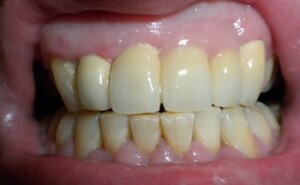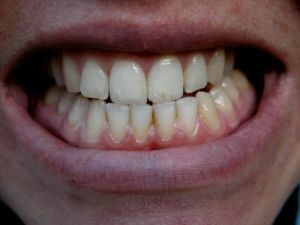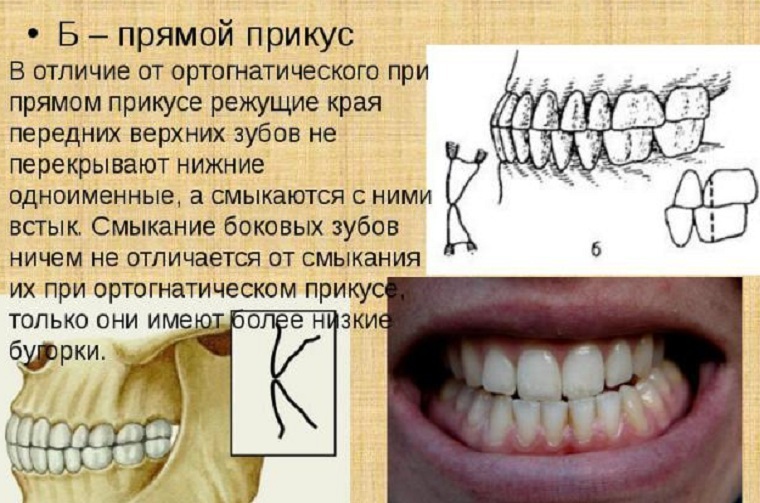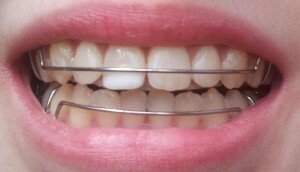 Direct bite has always been an association of a Hollywood smile, getting it from nature was considered luck, it refers to the types of right bite, in which the jaw adjacency is close to the ideal, namely, the lower incisors meet the upper ones.
Direct bite has always been an association of a Hollywood smile, getting it from nature was considered luck, it refers to the types of right bite, in which the jaw adjacency is close to the ideal, namely, the lower incisors meet the upper ones.
People with this bite lack external disproportion - the line between the central incisors coincides with the middle line of the face. Owners of such a closure of teeth do not suffer from speech disturbance, do not experience problems with chewing food.
Among the right bites, in addition to the direct biceps, there are also bipropgnatic and orthognathic ones. They can provide a full-fledged operation of the dentoalveolar system. They are referred to the physiological group of bites.
Contents
- Advantages and disadvantages
- Danger of direct jaw closure
- Symptomatics and diagnostic criteria
- Correction methods
Advantages and disadvantages of
Among the advantages of direct bite you can distinguish:
- Aesthetics .Ideal closing of the teeth is the guarantee of the beauty of the face. A smile with such teeth has always been spectacular and open.
- Absence of physiological anomalies .Owners of the right adjacency of the jaws do not suffer from problems with speech and other abnormalities, they have no complications in eating.
- No slots .With this arrangement of teeth, gaps in the dentition are absent. The incisors of the lower jaw tightly adhere to the upper, without forming lumens. Thanks to this smile looks full and holistic.
To the minuses of this type of occlusion, orthodontists refer:
- Appearance of anomalies .In some cases, a straight bite can develop into the bulging of the lower jaw. In this case, the
 should be promptly medically intervened.
should be promptly medically intervened. - Erasability of the tooth covering .A proper bite provides daily contact of the teeth, which can lead to not the desired destruction of the enamel. This not only affects the sensitivity, but also on the aesthetics, since the lower part will gradually decrease.
- Reloading the jaw .Teeth are in constant pressure against each other, thereby delivering discomfort.
- Diseases of the .Direct closure can cause dysfunction of the chewing joints and the appearance of a number of diseases, including periodontitis and caries. Sometimes patients complain of clicks during the opening of the mouth and even worsening of the hearing.
Danger of direct jaw closure
In some cases, direct closure of the teeth can be dangerous. Despite the fact that the enamel is considered to be a strong coating, with such a structure of the jaw, it can quickly be worn.
It is dangerous to have tooth decay. The increased load on the teeth also affects the grinding of their overall length and the appearance of problems with the high-jaw joint. In addition, with this form of occlusion, there may be abnormalities in diction, pain in the lower and upper jaws, and also in the head. If experts do not intervene in time, even a person has difficulty opening his mouth.
Timely response to the slightest discomfort and problems encountered will help to eliminate them qualitatively and avoid the appearance of pathologies and disturbances in the future.
Symptomatics and diagnostic criteria
Direct bite can even cause aesthetic defects and serious functional disorders. To aesthetic defects include the lower part of the face and the inverted lower lip. Lower teeth predominate above the upper and disrupt the bite of a person.
Functional disorders are accompanied by traumatization of the oral mucosa, as well as overloading of the teeth. As a result, such diseases as stomatitis, gingivitis and periodontitis develop. The patient begins to talk through his teeth, breathing becomes difficult, his speech becomes fuzzy and incomprehensible.
In order to determine the causes of the appearance of aesthetic defects or functional disorders, diagnosis is performed by an orthodontist, during which the structure of the jaw and the condition of the oral cavity are carefully studied. After the initial examination, the patient's complaints are carefully studied and the ways of correcting the present problems are determined.

The photo shows schematically and visually the direct bite of
. For better diagnostics:
- occlusion diagram;
- orthopantomography;
- teleradiography;
- electromyography.
In addition, for a detailed evaluation of the relationship of the dentition, an impression is made of the alginate mass and a diagnostic model is made. Also common photos of the face in profile and face are made. These diagnostic methods play an important role, because thanks to them, specialists can carefully analyze the structure of the lower and upper jaw and take further measures.
Correction methods
Correction of the problems of direct bite is a long and complex process, which requires large time and financial costs. The correction process depends on the age of the patient, the degree of neglect of the illness and the time of the beginning of the treatment procedures.
Treatment of anomalies of direct jaw closure is possible due to orthodontic devices:
- to Bracket systems. Direct bite is not always correct and does not guarantee that there will not be any dental problems. Braces are installed in case of serious violations in the structure of the jaw. In addition, thanks to braces, almost all of the dentoalveolar anomalies are treated.
- Kapam and retainers .The use of caps is considered a more practical option, since they are much more convenient to use. Kapy protect the dentition from erasure. In wearing, they are almost invisible, because they are made of transparent plastic, and care for them is not difficult. In childhood use trainers.
 Direct bite is indeed a guarantee of a beautiful smile, but sometimes it can cause some or other anomalies and irregularities. The lower and upper jaws exert daily pressure on each other, the enamel is erased, the teeth become thinner and become smaller - all this can result from the direct closing of the teeth.
Direct bite is indeed a guarantee of a beautiful smile, but sometimes it can cause some or other anomalies and irregularities. The lower and upper jaws exert daily pressure on each other, the enamel is erased, the teeth become thinner and become smaller - all this can result from the direct closing of the teeth.
Ignoring the problem can only worsen the general condition of the teeth and oral mucosa, after which serious and long-term treatment will be required. It is almost impossible to predict probable anomalies, which is why the teeth require constant care and prevention.
In order to avoid possible problems, it is necessary to take preventive measures in advance, which include:
- Power .The daily diet should contain the necessary amount of calcium and fluoride, which affects the healthy state of the teeth.
- Regular visit to the dentist .Detection of anomalies at the initial stage is the key to successful treatment of the disease.
- General health condition of .Harmful habits, the regime of the day and concomitant diseases affect the condition of the body.
